If you want to keep your vagina healthy, this information is for you!
Learn more about:
- What happens in your vagina?
- What is the vaginal microbiota?
- How to look after yourself to prevent vaginal infections?
- 1. Vaginal microbiota what is it? how does it work?
- 2. Vaginal microbiota at every stage in a woman's life
- 3. Vaginal microbiota a delicate balance
- 4. 10 tips to take care of your vagina
- 5. Let's talk about sex
- 6. Talking about vaginal health with my daughter
- 7. What shall you keep in mind on the vaginal microbiota?
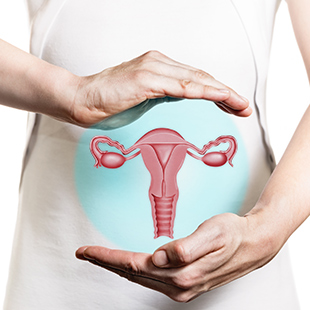
Vaginal microbiota what is it? how does it work?1-4
Did you know we're never completely alone?
We share our bodies with countless tiny bugs (microorganisms) that live on our skin, in our mouth, nose, intestine, and in our vagina.
Together these tiny organisms (bacteria, fungi, viruses…) make up the human microbiota.
The human microbiota plays an essential role in human life by regulating our natural defenses against disease, and ensuring our body functions.
An adult woman has between 1 million and 100 million bacterial cells per milliliter of secretions inside her vagina.1
Most vaginal microbiota contain bacteria called Lactobacilli that play an essential role in keeping your vagina healthy and protecting it from aggressive microbes.
Each woman has her own unique vaginal microbiota that maintains the right balance between the different microorganisms. Interestingly, it has recently been shown that the composition of the microbiota can vary according to geographic and ethnic origins.
What is Lactobacilli for your vagina? 1,10
- Lactobacilli constitute the “normal” vaginal bacterial flora of healthy women.
- Lactobacilli maintain a healthy acidic environment within the vagina (pH 3.5-4.5). This makes it inhospitable to other bacteria, thus preventing from growing.
- Lactobacilli can prevent pathogenic microorganisms from attaching to the lining of the vagina.
- Lactobacilli can produce hydrogen peroxide and natural antibiotics, called bacteriocins, which protect against harmful microbes.
- Lactobacilli can also boost the immune defences of the vagina.
Bibliography
1. Diop K, et al. Exhaustive repertoire of human vaginal microbiota. Hum Microb J. 2019;11:100051. https://doi.org/10.1016/j.humic.2018.11.002.
2. Gupta S, et al. Crosstalk between vaginal microbiome and female health: a review. Microb Pathog. 2019;136:103696. https://doi.org/10.1016/j.micpath.2019.103696.
3. Krishna SBN, et al. The vaginal microbiota in women health and disease: current understanding and future perspectives – A review. Curr Trends Biotechnol Pharm. 2017;11(2):190-205.
4. Amabebe E, et al. The vaginal microenvironment: the physiologic role of Lactobacilli. Front Med (Lausanne). 2018;5:181.
osition of vaginal microbiota: inclusion of nutrition and probiotic factors in the maintenance of eubiosis. Nutrients. 2020;12:419-49.
10. Kovachev S. Defence factors of vaginal lactobacilli. Crit Rev Microbiol. 2018;44:31-9.
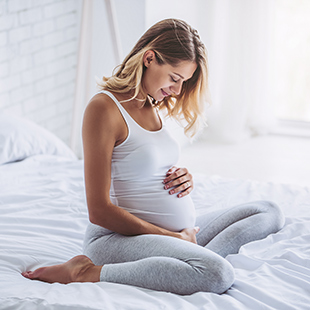
Vaginal microbiota at every stage in a woman's life2, 3, 5-7, 15
The composition of the vaginal microbiota changes with the different conditions of a woman's life:
Vaginal microbiota during childhood
During childhood, oestrogens levels are low and little girls have no Lactobacilli. During puberty with hormonal changes, the vaginal microbiota will evolve into that of an adult woman with the onset of Lactobacilli and the acidification of the vagina.
Vaginal microbiota during pregnancy
Levels of estrogen (female hormone) increase progressively during pregnancy. This causes a rise in the number ofLactobacilli and the microbiota remains therefore stable over time whereas in non-pregnant women, the microbiota changes during the menstrual cycle.
A stable microbiota is the 1st line defense against infections.
The less positive aspect is that Candida (microscopic fungi that normally live in the vagina without causing any trouble) also begin to increase in numbers. This is why pregnant women are more frequently affected by yeast infections.
Vaginal microbiota during postpartum period
Female hormones levels, which are elevated during pregnancy, drop significantly after delivery. Consequently, the quantity of Lactobacilliin the vagina diminishes and the balance of vaginal flora is disturbed. Post-partum women are therefore much more prone to infections.
Vaginal microbiota during menopause
During menopause, less oestrogen is produced. As vaginal cells receive less oestrogen, the vaginal wall becomes more vulnerable with dryness and the quantity of Lactobacilli in the vagina diminishes. Change of vaginal microbiota during menopause increase the risk of vaginal infection.
Vaginal microbiota during menstruation
Menstrual blood causes a temporary rise in the pH (becoming alkaline). This produces a drop in Lactobacilli numbers, which in turn makes it easier for other potentially harmful bacteria, such as Staphylococcus aureus, and toxic substances to develop. This is why tampons must be changed frequently.
As soon as your period ends
The ovaries start to produce more estrogen (female hormones). The moist coating inside the vaginal cavity (vaginal mucosa) starts to produce a substance (glycogen) that nourishes the Lactobacilli. The microbiota returns to normal.
The good bacteria then increase the acidity of the vaginal ecosystem, making it more capable of defending itself against harmful germs.
Bibliography
2. Gupta S, et al. Crosstalk between vaginal microbiome and female health: a review. Microb Pathog. 2019;136:103696. https://doi.org/10.1016/j.micpath.2019.103696.
3. Krishna SBN, et al. The vaginal microbiota in women health and disease: current understanding and future perspectives – A review. Curr Trends Biotechnol Pharm. 2017;11(2):190-205.
5. Greenbaum S, et al. Ecological dynamics of the vaginal microbiome in relation to health and disease. Am J Obstet Gynecol. 2019;220:324-35.
6. Kroon SJ, et al. Cervicovaginal microbiota, women’s health, and reproductive outcomes. Fertil Steril. 2018;110:327-36.
7. Kaur H, et al. Crosstalk between female gonadal hormones and vaginal microbiota across various phases of women’s gynecological lifecycle. Front Microbiol. 2020;11:151.
15. Neyazi SM. Prepubertal vaginitis. J Nat Sci Med. 2019;2:14-22.

Vaginal microbiota a delicate balance2, 4, 7-9
The vagina and its microbiota make up a fragile, delicately balanced ecosystem.
Lots of things can affect this delicate balance.
- Age and changes in hormone levels: menstrual cycle, pregnancy, menopause
- Sexual activity: numerous partners, unprotected sex
- Certain diseases, e.g., diabetes
- Smoking
- Inadequate hygiene
- Vaginal lubricants
- Alcohol abuse
- Certain medications (antibiotics, glucocorticoids, antiseptics)
- Stress
- Certain methods of contraception
How do these factors affect the balance of your vaginal microbiota?2-4, 7, 19, 20
Changes in oestrogen secretion
The vaginal microbiota evolves over time and changes with age. It can vary at puberty, during and after pregnancy, during menopause.Lactobacilli levels are strongly dependent on the quantity of hormones: the greater the levels of hormones, such as oestrogen, the greater the concentrations of Lactobacilli and the better the level of protection for the vagina.
Sexual activity
The number of sexual partner(s), certain sexual practices and the frequency of intercourse can lead to an imbalance in the vaginal microbiota.
When you change partners, there may be changes in the vaginal microbiota; and the more partners one has throughout one's life, the greater the phenomenon, with a potential imbalance of the vaginal microbiota.
It is important to remember to use condoms with a new partner until you have both been screened for sexually transmitted infections. Nevertheless, even if the test comes back negative, unprotected intercourse with a new partner or several partners increases the risk of vaginal microbiota imbalance and bacterial vaginosis.
Tobacco
Smoking affects the immune system and stimulates bacterial aggressiveness. Also, female smokers have less protective lactobacilli. The higher the tobacco consumption is, the greater the risk to imbalance your vaginal microbiota is. Thus, smokers of ten cigarettes per day have twice the risk of developing vaginosis than non-smokers.
Inappropriate hygiene habits that may lead to vaginal infections:
- Inappropriate hygiene habits and certain products promote vaginal infections by disrupting the vaginal barrier and weakening the vaginal microbiota such as vaginal douching, antiseptics, intimate deodorants.
- The use of panty liners, sanitary napkins and tampons outside your periods can alter the vaginal barrier and should therefore be avoided.
- The type of fabric of your underwear and how often you change it will both impact on the risk of infection. Nylon and other synthetic fabrics do not allow the area to breath as effectively as cotton. This creates a damp environment that is perfect for the growth of bacteria and the development of infections.
- Tight-fitting jeans and nylon underwear should be avoided as they tend to trap moisture and make it easy for bacteria to grow.
- Washing the genital region too often (more than once daily) may generate imbalance of your microbiota especially when you are using classical soap and increase your infection risk.
Certain medications (such as antibiotics, antiseptics, glucocorticoids) and certain types of contraception
When taken over the long term, someantibiotics weaken the vaginal microbiota, promoting the development of infections.
Antibacterial soaps dry the vulva and may be harmful to Lactobacilli and are able to alter the vaginal microenvironment; therefore, they should be used with caution in the genital area.
Glucocorticoids use can weaken the immune system over time, putting those who take them at risk of repeated infections. The main gynaecological complication is mycosis, with an imbalance of the microbiota.
Some methods of contraception, such as intra uterine device, can have an impact on your vaginal microbiota and promote its imbalance.
"Warning": Never stop the treatment prescribed by your doctor without medical advice on the pretext of preserving your vaginal well-being. Seek advice to your doctor or your pharmacist which can recommend you an alternative treatment with less impact on your vaginal microbiota or an additional treatment such as probiotics which help restore the balance of vaginal microbiota.
Stress. Women who are stressed have more frequent yeast infections and bacterial vaginosis. Thus, women exposed to chronic psycho-social stress have a 30% additional risk of developing bacterial vaginosis.
If the vaginal microbiota gets out of balance, the risk of infection is greater.
Change your bad habits to:
- Reduce the likelihood of harming your microbiota
- Lower your risk of infection
Bibliography
2. Gupta S, et al. Crosstalk between vaginal microbiome and female health: a review. Microb Pathog. 2019;136:103696. https://doi.org/10.1016/j.micpath.2019.103696.
3. Krishna SBN, et al. The vaginal microbiota in women health and disease: current understanding and future perspectives – A review. Curr Trends Biotechnol Pharm. 2017;11(2):190-205.
4. Amabebe E, et al. The vaginal microenvironment: the physiologic role of Lactobacilli. Front Med (Lausanne). 2018;5:181.
7. Kaur H, et al. Crosstalk between female gonadal hormones and vaginal microbiota across various phases of women’s gynecological lifecycle. Front Microbiol. 2020;11:151.
8. Muhleisen AL, et al. Menopause and the vaginal microbiome. Maturitas. 2016;91:42-50.
9. Barrientos-Durán A, et al. Reviewing the composition of vaginal microbiota: inclusion of nutrition and probiotic factors in the maintenance of eubiosis. Nutrients. 2020;12:419-49.
19. Gonçalves B, et al. Vulvovaginal candidiasis: Epidemiology, microbiology and risk factors. Critical Reviews in Microbiology 2016 42:6 (905-927)
20. Nastel T.R. et al. The association of psychosocial stress and bacterial vaginosis in a longitudinal cohort. Am J Obstet Gynecol. 2006 February; 194(2): 381–386.

10 tips to take care of your vagina2-5, 9-13, 21, 22
The vagina is a self-regulating ecosystem equipped with various defense mechanisms. Usually, the vagina is capable of protecting itself… but not always.
Easy ways to keep your vagina healthy
1: Practice safer sex
During sex, your vagina comes into contact with unknown bacteria from your partner. If you have a new partner, use a condom to avoid sexually transmitted infections.
2: Avoid smoking
Women who smoke have fewer vaginal Lactobacilli and therefore a greater risk of infection from harmful bacteria.
3: Limit antibiotics & antiseptics
Overuse of either of these will destroy not only the harmful bacteria but also the good ones.
4: Avoid vaginal douching or harsh cleaners & soaps
This disrupts your natural balance, increasing the risk of infections. Indeed, vaginal douching is the best way to unbalance the local microbiota. First, it can change the pH: the water has a pH of 8 while the vagina needs a pH between 3.5 and 4.5. In addition, the waterremoves the protective mucus of the vagina and its lactobacilli.
Since the vagina is a "self-cleaning" organ, you should never use vaginal douching (even with water alone). It is best to let your vagina clean itself naturally by making mucus, which washes away blood, semen, and vaginal discharge. There is therefore no point in internal douching, otherwise the self-cleaning mechanism of the vagina and its microbiota will be impaired. Cleaning should be limited to the external area alone.
5: Don't over-wash
Washing your external genitals once daily with anappropriate intimate hygiene product is enough.
Too much hygiene (especially when using classic soap instead of adapted product for intimate hygiene) is as harmful to vaginal health as poor hygiene. Indeed, it can disrupt your normal vaginal microbiota and dry out the mucous membrane. So, one external wash per day, maximum two is sufficient.
6: Wipe from front to back
Always wipe from front to back until the toilet paper is clean. The best way to prevent bacteria from getting into the vagina. Otherwise, the chances of transferring harmful bacteria to the vulva and the vagina are high.
7: Renew
Tampons and sanitary pads must be changed frequently during your period. Tampons must be changed every three to four hours and never kept for more than eight hours at night, otherwise there is a risk of infection with the development of toxic bacteria.
8: Avoid intimate perfumes & deodorants
They can affect the delicate balance of microbiota and cause irritation.
Any genital odors are either physiological - so with good normal hygiene the use of deodorants is not justified - or pathological, sign that there is some sort of infection, such as bacterial vaginosis. If that is case, the deodorant will only mask the problem without solving it and possibly even make it worse.
9: Avoid tight clothes and underwear in synthetic fabrics
Synthetic underwear is unable to absorb perspiration as effectively as coton undewear. The moisture leads to an increased risk of vaginal infections.
10: Change underwear frequently
However, avoid using tampons or protective pads outside of your period. They are likely to damage the wall of the vagina or cause dryness of the vulva by absorbing the natural secretions, which in turn may cause an imbalance of your vaginal microbiota. Don't take unnecessary risks.
Also, it is useless to get into the habit of introducing tampons as a preventive measure before going to a swimming pool to avoid getting a new mycosis. It is better to put on a dry swimsuit or underwear as soon as you get out of the water.
Bibliography
2. Gupta S, et al. Crosstalk between vaginal microbiome and female health: a review. Microb Pathog. 2019;136:103696. https://doi.org/10.1016/j.micpath.2019.103696.
3. Krishna SBN, et al. The vaginal microbiota in women health and disease: current understanding and future perspectives – A review. Curr Trends Biotechnol Pharm. 2017;11(2):190-205.
4. Amabebe E, et al. The vaginal microenvironment: the physiologic role of Lactobacilli. Front Med (Lausanne). 2018;5:181.
5. Greenbaum S, et al. Ecological dynamics of the vaginal microbiome in relation to health and disease. Am J Obstet Gynecol. 2019;220:324-35.
9. Barrientos-Durán A, et al. Reviewing the composition of vaginal microbiota: inclusion of nutrition and probiotic factors in the maintenance of eubiosis. Nutrients. 2020;12:419-49.
10. Kovachev S. Defence factors of vaginal lactobacilli. Crit Rev Microbiol. 2018;44:31-9.
11.Chen Y, et al. Role of female intimate hygiene in vulvovaginal health: global hygiene practices and product usage. Women’s Health. 2017;13(3):58-67.
12. Cottrell BH. Vaginal douching. J Obstet Gynecol Neonatal Nurs. 2003;32:12-8.
13. Bohbot JM, et al. Microbiote vaginal, la révolution rose. Marabout. 2018.
21. Felix T.C, et al. Evaluation of Vulvovaginitis and Hygiene Habits of Women Attended in Primary Health Care Units of the Family. International Journal of Women's Health 2020:12 49–57
22. NHS. Keeping your vagina clean and healthy. https://www.nhs.uk/live-well/sexual-health/keeping-your-vagina-clean-and-healthy/ . Accessed on March 8th 2021.
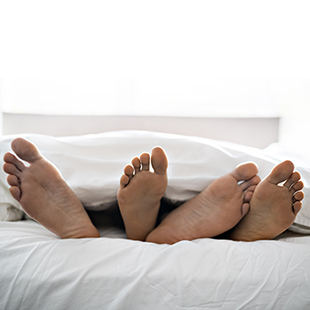
Let's talk about sex10-11, 13-14
Should I wash my vagina after sexual intercourse?
Don't practice vaginal douching after sexual intercourse!
The vagina is a "self-cleaning" organ. It should be left to clean itself naturally, which it does by producing natural secretions that remove blood, semen, and any vaginal discharge.
You only need to clean the outside area (the vulva) to preserve your vaginal microbiota.
Share these few tips on his personal hygiene with your partner:
- He also should wash his genitals every day.
- To clean the penis properly, the foreskin needs to be pulled back.
- The head of the penis (glans) is fragile so he should not use harsh cleaning products like antiseptics.
- If the glans becomes red, it does not necessarily mean that your partner has a yeast infection. He should never use an antifungal cream without first seeing a doctor.
Bibliography
10. Kovachev S. Defence factors of vaginal lactobacilli. Crit Rev Microbiol. 2018;44:31-9.
11.Chen Y, et al. Role of female intimate hygiene in vulvovaginal health: global hygiene practices and product usage. Women’s Health. 2017;13(3):58-67.
13. Bohbot JM, et al. Microbiote vaginal, la révolution rose. Marabout. 2018.
14. NHS. How to keep a penis clean. https://www.nhs.uk/live-well/sexual-health/how-to-keep-a-penis-clean/ . Accessed on January 14th 2021.

Talking about vaginal health with my daughter12, 15-18
Mothers play an essential role in teaching their daughters about personal hygiene.
A young girl’s vulva is delicate, even more so than that of an adult woman
Good hygiene practice starts early
Mothers must encourage little girls to take the time they need to ensure they are clean, to wash the genital area by hand from front to back, to clean around the anus properly, to rinse carefully, and lastly, to dry the area thoroughly with a clean towel.
Avoid harsh soaps and bubble bath as well as tight-fitting clothing and synthetic underwear.
Little girls should not hold on too long before going to the toilet. While urinating, they should not press legs tightly together.
Wiping is important; teach your little girl how to wipe herself after urinating or defecating, and to do it properly, from front to back.
Always seek medical advice if your little girl's vulva seems red and irritated, or if there is an abnormal discharge.
Why is your daughter's vaginal microbiota different from yours?15
The composition of the vaginal microbiota changes over time, based on changing estrogen levels.
Vaginal microbiota of young girls does not contain Lactobacilli and its pH is neutral.
In the peripubertal period (starting around 7 years of age), sex hormone secretion begins and increases as puberty progresses. These hormonal changes, and specifically the increase of oestrogen, will cause the vaginal microbiota of a young girl to evolve into that of an adult woman with the onset of Lactobacilli and the acidification of the vagina.
Bibliography
12. Cottrell BH. Vaginal douching. J Obstet Gynecol Neonatal Nurs. 2003;32:12-8.
15. Neyazi SM. Prepubertal vaginitis. J Nat Sci Med. 2019;2:14-22.
16. Beyitler I, et al. Clinical presentation, diagnosis and treatment of vulvovaginitis in girls: a current approach and review of the literature. World J Pediatr. 2017;13(2):101-5.
17. Lanis A, et al. Prepubertal and adolescent vulvovaginitis: what to do when a girl reports vaginal discharge. Pediatr Ann. 2020;49(4):e170-e175.
18. Zukerman, et al. Clinical recommendation: vulvovaginitis. J Pediatr Adoles Gynecol. 2016;29:673-9.

What shall you keep in mind on the vaginal microbiota?1, 3
The term vaginal microbiota refers to the different bacteria that live inside the vagina.
The vaginal microbiota of each woman is unique and changes continuously throughout her life.
Lactobacilli are the good bacteria; in a healthy vagina, they outnumber the harmful bacteria thus protecting the vagina from infection.
A healthy lifestyle with good intimate hygiene is essential to maintaining a healthy vaginal microbiota and thus avoiding infections.
Don't hesitate to talk to your doctor.
Bibliography
1. Diop K, et al. Exhaustive repertoire of human vaginal microbiota. Hum Microb J. 2019;11:100051. https://doi.org/10.1016/j.humic.2018.11.002.
3. Krishna SBN, et al. The vaginal microbiota in women health and disease: current understanding and future perspectives – A review. Curr Trends Biotechnol Pharm. 2017;11(2):190-205.
IS YOUR VAGINAL HEALTH AT RISK?
VAGINAL INFECTIONS : QUESTIONS & ANSWERS
Read on to find out:
- What vaginal infections are?
- What to do if you think you have a vaginal infection?
- How to prevent vaginal infections?
- 1. First of all, what are vaginal infections?
- 2. How do i know if i have a vaginal infection?
- 3. How to treat vaginal infections?
- 4. How can i improve my vaginal health and prevent my vaginitis from coming back?
- 5. I have a vaginal infection. what should my partner do?
- 6. My daughter suffers from vaginitis, what should i do?
- 7. Vaginal infections: what you should keep in mind?

First of all, what are vaginal infections?1-6
Women who have repeated vaginal infections see their quality of life strongly altered. 1, 6
If you experience itching, burning, discharge or an unpleasant smell in the genital area, it may be a sign that you have a vaginal infection.
There are different types of vaginal infections:
What is vulvovaginal candidiasis 1, 3, 7, 24 (yeast infection)?
caused by an excess of yeast in the vagina (candida albicans or candida non-albicans).
This infection affects both the vulva and the vagina. Candida is normally present in the vagina of most women, but also in other parts of the body such as the intestine or the skin. It comes in several varieties: albicans, glabrata, krusei, etc…
In the vagina, Candida albicans develops as harmless spores. But under the influence of external events, the latter begins to produce hyphae that gradually penetrate the vaginal wall and damage it. This aggression causes inflammation and pain, itching, burning, white discharge... In addition, Candida secretes toxins which aggravate local inflammation.
Some situations, such as antibiotic or corticosteroid use, pregnancy or diabetes may be linked to Candida growth. Vulvovaginal candidiasis is usually not transmitted sexually.
What is bacterial vaginitis? 4
It is caused by aerobic bacteria (that develop in the presence of oxygen) bacteria, mainly from the gut, such as E. coli or other bacteria such as Staphylococcus or Streptococcus.
Bacterial vaginitis is characterized by an inflammation of the vagina with irritation and burning. It is accompanied by unusual vaginal discharge often yellowish.
What is a mixed vaginal infection? 5, 25
Is when at least two different microbes are responsible for the vaginal infection.
Approximately 20% to 30% of women with bacterial vaginosis are coinfected with candida species (vulvovaginal candidiasis) and over half of women with bacterial vaginitis would have mixed infections with vulvovaginal candidiasis, bacterial vaginosis or with trichomoniasis.
Bacterial vaginosis 1,3, 4, 7
It is caused by a change in the delicate balance of naturally occurring bacteria: Lactobacilli—the “friendly” bacteria—drop in numbers and are replaced by Gardnerella vaginalis and other mainly anaerobic (that do not require oxygen) bacteria.
Lactobacilli play an essential role in keeping your vagina healthy and protect it from aggressive microbes. A depletion of these bacteria imbalances the vaginal microbiota and allows the proliferation of harmful bacteria in the vagina such as Prevotella, Gardnerella vaginalis, Atopobium vaginae…
Having multiple sex partners, a new sex partner, douching, lack of condom use, increase the risk of bacterial vaginosis. Furthermore, women with bacterial vaginosis are at increased risk for the acquisition of some sexually transmitted infections.
What is trichomonas vaginalis infection (trichomoniasis)? 7, 18
A sexually transmitted infection (STI) caused by a small parasite called Trichomonas vaginalis.
The term ”sexually transmitted infections” refers to a variety of infections caused by pathogens that can be acquired and transmitted through sexual activity such as syphilis, chlamydial infection, gonococcal infection, trichomoniasis, human papillomavirus, herpes virus or HIV infections.
Using condoms helps protect against STIs when you have sex.
If there is an inflammation of the vagina, it is called vaginitis, if no, bacterial vaginosis.
Bibliography
1. Paladine HL, et al. Vaginitis: diagnosis and treatment. Am Fam Physician. 2018;97:321-9.
2. Sherrard J, et al. 2018 European (IUSTI/WHO) International Union against sexually transmitted infections (IUSTI) World Health Organisation (WHO) guideline on the management of vaginal discharge. Int J STD AIDS. 2018;29:1258-72.
3. Hainer BL, et al. Vaginitis: diagnosis and treatment. Am Fam Physician. 2011;83:807-15.
4. Jones A. Bacterial Vaginosis: a review of treatment, recurrence, and disparities. J Nurse Pract. 2019;15:420-3.
5. Sobel JD, et al. Mixed vaginitis – more than coinfection and with therapeutic implications. Curr Infect Dis Rep. 2013;15:104-8.
6. Aballéa S, et al. Subjective health status and health related quality of life among women with recurrent vulvovaginal candidosis (RVVC) in Europe and the USA. Health Qual Life Outcomes. 2013;11:169.
7. Centers for Disease Control and Prevention. Sexually transmitted diseases treatment guidelines, 2015. Reviewed 2019. [on line]. https://www.cdc.gov/std/ tg2015/default.htm
18. NHS. How to keep a penis clean. https://www.nhs.uk/live-well/sexual-health/how-to-keep-a-penis-clean/. Accessed on January 14th 2021.
24. Rodríguez-Cerdeira C, et al. Biofilms and Vulvovaginal Candidiasis. Colloids Surf B Biointerfaces. 2019 Feb 1;174:110-125.
25. Fan A, et al. Aerobic vaginitis and mixed infections: comparison of clinical and laboratory findings. Arch Gynecol Obstet. 2013; 287:329-35.
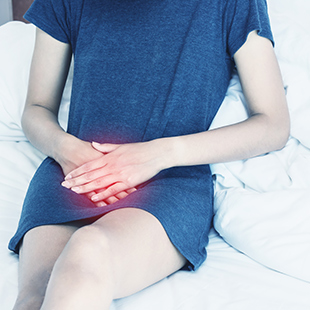
How do i know if i have a vaginal infection?1-3, 6, 7
In vulvovaginal candidiasis (yeast vulvovaginal infection)
Both the vulva and the vagina are affected.
The main symptoms to watch out for are:
- irritation and burning sensations,
- itching,
- abnormal vaginal discharge (white, thick and curdy),
- pain during sexual intercourse and urination.
These symptoms cause discomfort and pain that can vary but are often severe.
In bacterial vaginosis
The vaginal discharge is thin and white or grey, with an unpleasant “fishy” smell that may become more noticeable after intercourse or during your period.
- Bacterial vaginosis is not associated with vaginal inflammation and rarely causes irritation of the vulva or pain during intercourse.
- Up to 50% of women diagnosed with bacterial vaginosis have no symptoms.
In trichomoniasis(trichomonas vaginalis infection)
The discharge is frothy and greenish-yellow.
- Women with trichomoniasis frequently experience pain during sexual intercourse but many women may have no symptoms.
If you are diagnosed with a sexually transmitted infection, your partner will need to be treated too.
Be careful!
Unpleasant or bothersome symptoms may not be due to an infection. They can be caused by allergic or irritant reactions to feminine hygiene products, or due to lower levels of estrogen (as can be seen in women during or aftermenopause).
That is why it is so important to talk and seek medical advice.
Your doctor will:
- ask questions about your medical history,
- perform a physical gynecological examination,
- conduct or prescribe office-based or laboratory tests where necessary.
Only then will your doctor be able to make the right diagnosis and prescribe the most appropriate treatment for you.
Bibliography
1. Paladine HL, et al. Vaginitis: diagnosis and treatment. Am Fam Physician. 2018;97:321-9.
2. Sherrard J, et al. 2018 European (IUSTI/WHO) International Union against sexually transmitted infections (IUSTI) World Health Organisation (WHO) guideline on the management of vaginal discharge. Int J STD AIDS. 2018;29:1258-72.
3. Hainer BL, et al. Vaginitis: diagnosis and treatment. Am Fam Physician. 2011;83:807-15.
6. Aballéa S, et al. Subjective health status and health related quality of life among women with recurrent vulvovaginal candidosis (RVVC) in Europe and the USA. Health Qual Life Outcomes. 2013;11:169.
7. Centers for Disease Control and Prevention. Sexually transmitted diseases treatment guidelines, 2015. Reviewed 2019. [on line]. https://www.cdc.gov/std/ tg2015/default.htm
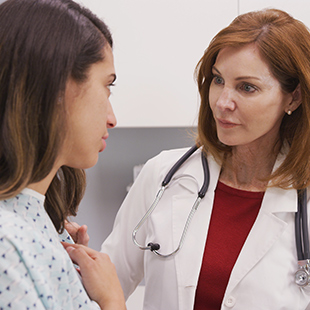
How to treat vaginal infections?3, 4, 7-13
Your doctor will prescribe a treatment that combats the cause(s) of your infection and that is adapted to your medical situation.
Avoid treating yourself without your doctor’s advice
Over-the-counter treatments may seem like an easy solution to an annoying or embarrassing problem. However, many have never been shown to be effective.
Some may provide temporary relief of certain symptoms, but this will only delay initiation of the treatment you actually need. And on top of that, many of these easily available treatments may act as an irritant and make the symptoms worse!
Think about it: a so-called remedy for infectious vaginitis will have no effect at all if your symptoms are not in fact caused by an infection!
Symptoms of vaginal infections can vary greatly
There is no specific symptom that distinguishes one infection from another. Identifying the exact cause is therefore complex, especially since one symptom can have several causes, and some women have multiple causes.
Think about it: 2 out of 3 women who self-diagnose and use vaginal antifungals, don’t actually have vulvovaginal candidiasis!
Certain bacteria are resistant to some treatments. This means that the wrong treatment will have no effect and the problem will persist.
Remember that some anti-infective treatments may damage the naturally present, protective Lactobacilli.
So you see, only your doctor can make the correct diagnosis and prescribe the right treatment.
The sooner you make an appointment, the better.
What are the treatments of vaginal infections?
- Various treatments exist such as antibiotics, antifungals and associations of both.
- It may be oral treatment by pills or intravaginal medication with different pharmaceutical forms such as vaginal pessaries, creams (usually prescribed together in case of vulvovaginal candidiasis) or soft capsules.
- If you have some difficulties to introduce solid pharmaceutical forms into your vagina (for example, in case of pain or dryness in the vagina), talk to your doctor or your pharmacist. Application of a vaginal cream or vulvo-vaginal instillation of the treatment with a specific pharmaceutical form may be done.
- All these treatments have their proper microbial activity and different durations of treatment.
- It is important to know that some topical medications such as creams or pessaries may weaken latex condoms for several days after use because of their oil-based nature. Refer to condom product labeling for further information.
Once you have been given the right treatment, remember to follow your prescription carefully.
Take your treatment for the full recommended time - never stop just because the symptoms subside.
Treatment duration times have been carefully determined for maximum efficacy.
If you do stop before the recommended treatment end, the infection will remain active and very likely flare up again soon.
Even worse, the bacteria may become resistant to the treatment, which will likely not be at all effective next time you take it.
Bibliography
3. Hainer BL, et al. Vaginitis: diagnosis and treatment. Am Fam Physician. 2011;83:807-15.
4. Jones A. Bacterial Vaginosis: a review of treatment, recurrence, and disparities. J Nurse Pract. 2019;15:420-3.
7. Centers for Disease Control and Prevention. Sexually transmitted diseases treatment guidelines, 2015. Reviewed 2019. [on line]. https://www.cdc.gov/std/ tg2015/default.htm
8. Ferris DG, et al. Over-the-counter drug misuse associated with patient-diagnosed vulvovaginal candidiasis. Obstet Gynecol. 2002;99:419-425.
9. Angotti LB, et al. Vaginitis: making sense of over-the counter treatment options. Infect Dis Obstet Gynecol. 2007; Article ID 97424. doi:10.1155/2007/97424.
10. Sihvo S, et al. Self-medication with vaginal antifungal drugs: physicians’ experiences and women’s utilization patterns. Fam Pract. 2000;17:145-9.
11. Bradshaw CS, et al. Current treatment of bacterial vaginosis—limitations and need for innovation. J Infect Dis. 2016:214 (Suppl 1):S14-20.
12. Melkumyan AR, et al. Effects of antibiotic treatment on the lactobacillus composition of vaginal microbiota. Bull Exp Biol Med. 2015;158:766-8.
13. Neut C, et al. Topical treatment of infectious vaginitis: effects of antibiotic, antifungal and antiseptic drugs on the growth of normal vaginal 15. Lactobacillus strains. Open Journal of Obstetrics and Gynecology. 2015;5:173-80.
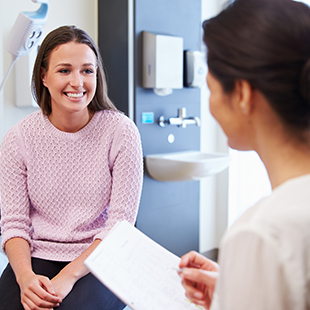
How can i improve my vaginal health and prevent my vaginitis from coming back?8-10, 14-17
Tips for avoiding genital infections
- Keep your genital area clean using appropriate hygiene products, but do not over-wash!
- Avoid vaginal douching, which washes away the good bacteria too.
- Fungi thrive in warm, humid environments so always remove your wet swimsuit as soon as you get out of the water.
- Avoid tight clothes and underwear in synthetic fabrics.
- Avoid self-medication. Incorrect diagnosis + inappropriate treatment = the infection is likely to get worse and to keep coming back.
- Always use a condom when you have sex with a new partner.
Bibliography
8. Ferris DG, et al. Over-the-counter drug misuse associated with patient-diagnosed vulvovaginal candidiasis. Obstet Gynecol. 2002;99:419-425.
9. Angotti LB, et al. Vaginitis: making sense of over-the counter treatment options. Infect Dis Obstet Gynecol. 2007; Article ID 97424. doi:10.1155/2007/97424.
10. Sihvo S, et al. Self-medication with vaginal antifungal drugs: physicians’ experiences and women’s utilization patterns. Fam Pract. 2000;17:145-9.
14. Chen Y, et al. Role of female intimate hygiene in vulvovaginal health: global hygiene practices and product usage. Women’s Health. 2017;13(3):58-67.
15. Cottrell BH. Vaginal douching. J Obstet Gynecol Neonatal Nurs. 2003;32:12-8.
16. Barrientos- Durán A, et al. Reviewing the composition of vaginal microbiota: inclusion of nutrition and probiotic factors in the maintenance of eubiosis. Nutrients. 2020;12:419-49.
17. Bohbot JM, et al. Microbiote vaginal: la revolution rose. Marabout. 2018.

I have a vaginal infection. what should my partner do?17, 18
Tips for your partner:
- He too should wash his genitals every day. This should be done gently, using a mild soap or specially formulated product. Do not use antiseptics.
- To clean the penis properly, the foreskin needs to be pulled back.
- There is no need to wash more to prevent an infection.
- If the glans becomes red, it does not necessarily mean he has a yeast infection. He should never use an antifungal cream without first seeing his doctor.
Bibliography
17. Bohbot JM, et al. Microbiote vaginal: la revolution rose. Marabout. 2018.
18. NHS. How to keep a penis clean. https://www.nhs.uk/live-well/sexual-health/how-to-keep-a-penis-clean/. Accessed on January 14th 2021.

My daughter suffers from vaginitis, what should i do?19-23
Vulvovaginitis is extremely frequent in young girls
As a mother, you can help by making sure:
- she doesn’t wear tight-fitting clothes,
- she only uses very gentle, non-perfumed soaps,
- she wears white cotton underwear and changes frequently,
- she keeps her genital area clean and dry,
- she understands how to wipe herself carefully, from front to back, after going to the toilet.
And remember that the most important first step is to consult your doctor.
This will ensure you get the right diagnosis and the correct treatment for your daughter.
Bibliography
19. Joishy M, et al. Do we need to treat vulvovaginitis in prepubertal girls? BMJ. 2005;330:186-8.
20. Neyazi SM. Prepubertal vulvovaginitis. J Nat Sci Med. 2019;2:14-22.
21. Beyitler I, et al. Clinical presentation, diagnosis and treatment of vulvovaginitis in girls: a current approach and review of the literature. World J Pediatr. 2017;13(2):101-5.
22. Lanis A, et al. Prepubertal and adolescent vulvovaginitis: what to do when a girl reports vaginal discharge. Pediatr Ann. 2020;49(4):e170-e175.
23. Zukerman, et al. Clinical recommendation: vulvovaginitis.J Pediatr Adoles Gynecol. 2016;29:673-9.

Vaginal infections: what you should keep in mind?4, 7-11
- Vaginal infections are frequent during your reproductive years but can also affect young girls and postmenopausal women.
- Vaginal infections occur when there is an imbalance in the proportions of bacteria in the vagina—the vaginal microbiota.
- When harmful bacteria outnumber the natural protective bacteria, this creates an environment where unwanted bacteria or yeast can develop.
- In some cases, such as trichomoniasis, pathogens are acquired only through sexual activity.
Remember!
Different bacteria cause different types of vaginal infections.
Treatment must be tailored to each individual situation.
The earlier you seek medical advice, the earlier you can start the right treatment, and the sooner the infection will be cured.
Attempting to make your own diagnosis can lead to the wrong treatment, which increases the risk of the infection coming back.
Always seek medical advice if you have questions about your vaginal health. Only your doctor can give you reliable information, clear guidance, and a medical prescription adapted to your particular case.
Bibliography
4. Jones A. Bacterial Vaginosis: a review of treatment, recurrence, and disparities. J Nurse Pract. 2019;15:420-3.
7. Centers for Disease Control and Prevention. Sexually transmitted diseases treatment guidelines, 2015. Reviewed 2019. [on line]. https://www.cdc.gov/std/ tg2015/default.htm
8. Ferris DG, et al. Over-the-counter drug misuse associated with patient-diagnosed vulvovaginal candidiasis. Obstet Gynecol. 2002;99:419-425.
9. Angotti LB, et al. Vaginitis: making sense of over-the counter treatment options. Infect Dis Obstet Gynecol. 2007; Article ID 97424. doi:10.1155/2007/97424.
10. Sihvo S, et al. Self-medication with vaginal antifungal drugs: physicians’ experiences and women’s utilization patterns. Fam Pract. 2000;17:145-9.
11. Bradshaw CS, et al. Current treatment of bacterial vaginosis—limitations and need for innovation. J Infect Dis. 2016:214 (Suppl 1):S14-20.
VAGINAL HEALTH: TAKE THE TEST!

Written with the help of Dr. Jean-Marc Bohbot, an infectious disease physician specialized in urogenital infections, and Head of the Sexually Transmitted Infections department at the Alfred Fournier Institute in Paris, France. Dr. Bohbot is also the author of several works intented for the general audience on sexually transmitted infections and the vaginal microbiota.




